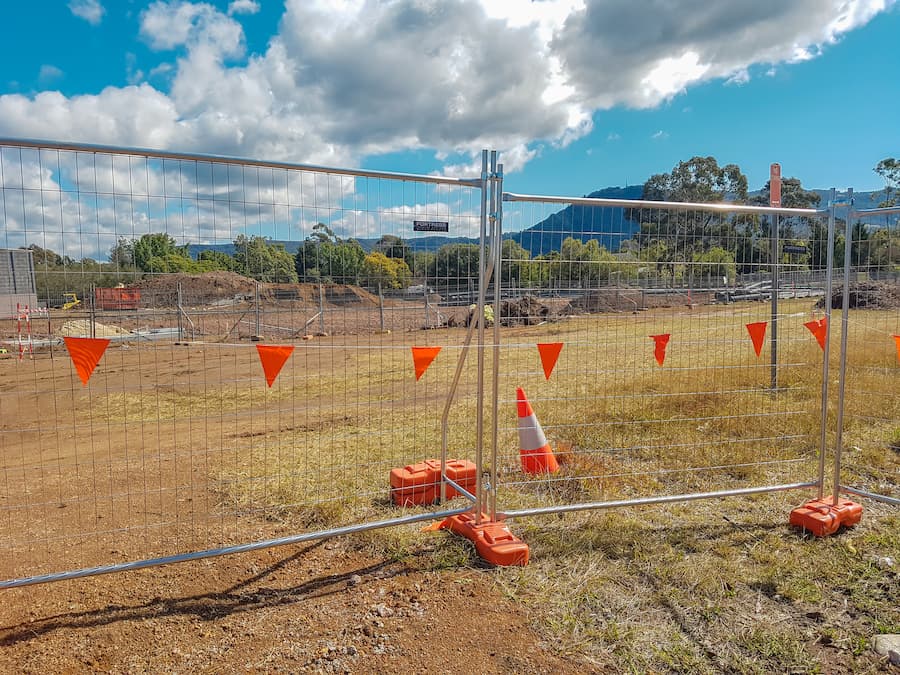Brace yourself! How to brace your temporary fence

Our top tips before you invest in temp fence bracing
Bracing is an essential part of a sturdy temporary fencing system. Temporary fence bracing provides reinforcement and therefore extra support to long straight tracts of temporary fence. Additionally, it ensures fences are less likely to be hampered by wind and weather. It also provides a counterweight support for fences covered in banner mesh or shadecloth.
With a range of fence bracing options available, it can therefore be tricky to find the type of bracing you may need for your site.
What Kind Of Bracing Do I Need?
Temporary fence bracing is constructed in different ways for different purposes. Certain types of braces are better for strong weather. Conversely, others are suited to supporting fences covered in banner mesh or netting.
Making Your Temp Fence Wind Resistant
Firstly, consider include the weather – if your site is located in a high wind area you may require a standard brace. On the other hand, for extremely windy areas we suggest the use of an ‘F-frame’ fence brace. This will provide added stability and peace of mind at your site.
Long straight runs of fencing can be prone to toppling over in windy areas. This can occur even if workers have secured them in the correct way with concrete or Polyblok fence feet.
Therefore the addition of a temporary fence bracing rail or strut can provide added stability. It will therefore enable the temp fence panels to resist tipping over when the wind picks up.
So what constitutes ‘high wind’? You might like to check out our wind load chart on page 4 of the Fortress Fencing Installation Guide. This details some suggested bracing configurations per fence panel, depending on where you're located. Ultimately though, you should perform your own wind assessment at your site.
Extra Support For Fences With Netting Or Mesh
Temporary fencing panels allow for the attachment of shade cloth for screening or dust control. Additionally, banner mesh is often used for promotional display and safety signage. Therefore, if you are using shade cloth or any kind of mesh, consider this extra weight and its effect on the fence.
Shadecloth, like banner mesh, construction netting and scrim, can affect a fence's stability. Although it may not be extremely heavy, it can ultimately add an unevenly distributed weight on one side of the fence.
Although banner mesh or shade cloth can have wind management features, such as slits or an open weave fabric, it can still be prone to catching the wind. Banner mesh is generally constructed so as not to act as a sail, but heavy or gusting wind may still have some minor effect on the mesh. This in turn affects the stability of the fence. In these cases, we recommend heavy duty temporary fence bracing such as the Fortress Fencing F-frame brace.
Note that it’s best to install temporary fence bracing prior to fixing any banner mesh, shadecloth or large signs to your fence. In fact, shade cloth and banner mesh may only be installed on braced fencing. Shade cloth and mesh must be firmly secured to the top rail of the fence with cable ties. However, it is not recommended to secure the shade cloth or banner mesh at the bottom, as this will restrict air flow and enhance the 'sail' effect.
Bracing For Straight Fences
Straight fences can become more unstable the longer they are, and therefore long runs of temp fence need bracing.
Fortress Fencing recommends that any temporary fencing is to be installed to a maximum of 3° out of plumb before extra bracing is required. Further to this, the temporary fence should have a standard brace installed every 6 panels.
Other Considerations
Consider how and where you are installing your temp fence braces. For public safety, bracing must not impact pedestrian walkways or heavily trafficked areas. Also, your bracing installation should be up to code - check for any relevant guidelines in your local area before installing.
Temp Fence Feet To Match Your Bracing
In addition to wind and weather, the style of fence feet you choose has a bearing on the kind of temporary fence bracing you will need. Styles of feet include Polyblok and also concrete filled plastic feet. Before purchasing your bracing or stays, ensure they are compatible with any existing fence feet you wish to use. It's worth noting that standard bracing needs an additional fence foot to slot into as well. This additional foot is then positioned out from the fence to suit the angle of the brace.
Types Of Bracing
Standard Brace
Product Code: 01-BRACE This temp fence bracing is ideal for high wind areas with long, straight runs of fencing. Standard bracing suits Fortress Fencing Polyblok feet and concrete filled fence feet.
Heavy Duty Brace
Product Code: 01-BRACEH
Heavy duty bracing is good for applications where a privacy or banner mesh is used. Up to 4 feet can support one brace. Heavy duty bracing suits Fortress Fencing Polyblok feet and concrete feet.
F-Frame Brace
Product Code: 01-FFRAME
The ‘F-Frame’ support frame is used instead of the standard brace where the fence is installed in an extreme wind area. It can also be used where the fence uses shade cloth. The F-Frame requires two heavy duty couplers (supplied), and can fit up to 4 feet.
33mm Heavy Duty Brace
Product Code: 03-FBRACE33B
This heavy duty support is designed to support the Fortress Fencing 2000 Series panels in high wind areas. The heavy duty 33mm brace requires two heavy duty couplers (supplied), and can fit up to 4 feet.
Need a hand?
If you need some specialist advice on a temporary fencing system to suit your unique project, our friendly team are here to assist! Simply give Jaybro a call on 1300 885 364.
 Sign In
Sign In 





